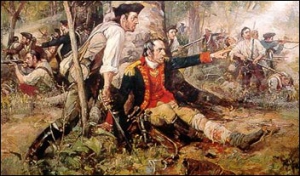Dear Donald,
Enjoy this reflection on Brigadier General Nicholas Herkimer.
As promised last month we have a report from Angie, our family guardian angel.
| GENERAL HERKIMER REVISITED |
Ray Jerrems, Our Genealogist, Historian, with Research by Sandra Walcyk
Introduction
Recently we have had quite a lot of coverage of our Australian connections, so I thought that we should visit the United States again. Why not go the whole hog by revisiting the heroic story of General Herkimer in the American Revolutionary War (known in Australia as the American War of Independence) for a good helping of patriotic fervor?
We last heard of Brigadier General Nicholas Herkimer, the cousin of Sandra’s great great great great great great great great grandmother (this is eight “greats”) in the June 2008 Journal. Readers may recall that “Cousin Nick” led a military unit of approximately 800 men which was ambushed in July 1777 at Oriskany Creek by 1500 British militia. He was shot in the leg but in a scene which has become famous in United States history he continued to direct the battle, leaning against a tree. About a quarter of his men were lost.
After the battle he was taken 40 miles to his home in the town of Danube. His leg was amputated later but, not surprisingly for those times, it was too late and he did not survive the operation.
To make things confusing, there are two monuments to General Herkimer and the Battle of Oriskany. They both resemble the Washington Monument, in miniature. One is at the Oriskany Battlefield State Park near Rome, NY, and the other is in the Herkimer Family Cemetery at the Herkimer Home State Historic Site in Danube, NY.
| The Battle of Oriskany |
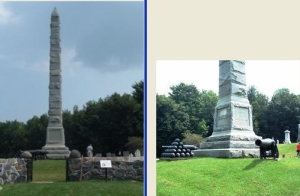
There is a tendency to treat the American Revolutionary War as a war between the British redcoats against Colonial regular troops. However the British did not have enough “regulars”, nor were there enough Hessian troops (troops from Hesse in what is now Germany, hired by the British Government) so they drew on locals to form militia units and Indians from some of the tribes of the Iroquois Six Nations Confederation (in this Battle, the Senecas and Mohawks). Similarly the regular Colonial troops were supplemented by militia units and (in the case of this Battle) Oneida Indians.
In the Battle of Oriskany almost all the participants on both sides were militia, supplemented by Indians. The British militia ambushed the Colonial militia, who were following a rough road through a narrow timbered valley in the direction of Fort Stanwix, which was occupied by the Colonials but was under threat from the British. However the British militia sprung the trap prematurely and many of the Colonials were able to escape the trap. The Battle descended into a number of skirmishes in the timbered area.
The shortcomings of the firearms (compared with modern weapons) were quickly apparent. At one stage fighting stopped for an hour due to heavy rain which prevented the use of the muzzle-loading muskets.
Another feature of the muskets was that they took a minimum of 20 seconds to load. For a while the Indians supporting the British troops were rushing out when an opponent fired his weapon and attacking him before he could reload. General Herkimer countered this by ordering his men to work in pairs behind trees. When the first soldier fired, the second waited for the Indian to run out, then shot him.
Perhaps this account has a hint of “folklore” in it.
The battle was fairly evenly balanced, until cannon shots from the Fort signalled that Colonial reinforcements had set off from the Fort, whereupon the British militia withdrew.
| Herkimer House |
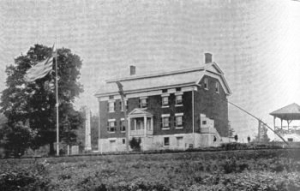
[The General Herkimer Home, built of brick in 1764, is described as “a fine example of a Mohawk River Colonial house. It has a most picturesque location on the edge of the Mohawk River flatlands with the wooded heights of Fall Hill rising to the westward.” In fact the family only lived in the house for 50 years. The house has been restored and is open to the public as a museum during the summer months.
| The guns used in the Battle |
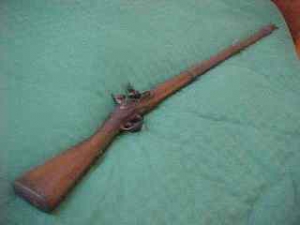
It is interesting for Australian readers to note that the War took place not long after Captain Cook landed in Botany Bay, when military weapons were rudimentary by modern-day standards. The main infantry weapon was the muzzle loading flintlock musket, which had a barrel about the same length as current rifles, but the resemblance ended there. They had the following drawbacks:
(a) As previously mentioned they took a long time to load, with 13 individual actions required, including putting gunpowder (from a paper packet known as a cartridge, which held a pre-measured quantity of gunpowder and a ball) down the barrel, then the ball, ramming wads of paper down the barrel with a ramrod, and priming the firing mechanism with gunpowder.
(b) Highly trained soldiers could load a musket in 20 seconds but this required a lot of mental discipline in the heat of battle with the enemy advancing.
(c) The effective range was about 60 yards/metres.
(d) The muskets did not have sights for aiming.
(e) The smooth bore of the musket and undersized round balls resulted in poor accuracy because the balls “wobbled” in transit.
(f) They could not be fired in wet weather because the gunpowder (particularly the powder used to prime the firing device) could get wet.
Treatment of wounds
Sadly, it is not surprising that General Herkimer died as the result of the leg wound. Knowledge of medical hygene was rudimentary in those days, and in all probability the wound soon became infected. Even in hospitals over 30% of patients who had been operated on died from infections. By the time the amputation procedure took place at his home eleven days later he would have been in a bad way from gangrene. Added to this, there were no medical anaesthetics until the discovery of ether and chloroform in the 1840s to reduce pain and trauma, the only assistance being a bottle of rum. The risk of bleeding to death as the result of amputation would also have been high.
The end result was that poor Cousin Nick was probably doomed the moment he was wounded.
| Fort Stanwix |

This was one of about four forts originally built by the British in 1758 at the huge cost of $266,000 to protect the Mohawk River settlements from Franco-Indian advances into the Mohawk Valley, in which it was successful.
From drawings made at the time it can be seen that it was quite large. It had cannons, which were possibly intended for use against French ships and conventional military columns rather than the dispersed militia used in the Battle of Oriskany.
Re-enactments of military events
Re-enactments of military events are popular in America and Europe. Replicas of uniforms, weapons and equipment are readily available on the internet. The result is that battles such as the Battle of Oriskany are re-enacted periodically, the first re-enactment of that Battle being in 1970. The re-enactments of the Oriskany Battle include a march from Herkimer’s house to the battlefield.
Military significance of the Battle
The author of books on the Battle has said of Herkimer’s actions after he was wounded:
“His junior officers beg Herkimer to allow them to move him to a place of safety, for even now the enemy is attempting to penetrate the ragged circle of citizen soldiers and Oneida warriors protecting him, but this was his reply: In one of the defining moments in American History, the General unsheathed his sword and thrust it(s) blade down into the soil, exclaiming- “No I will face the enemy!” His immortal words electrify those around him and quickly circulate throughout the battered command grimly holding onto their fragile position on the Western heights and tip of the Eastern Ravine.”
Another author has said “The effect of the American defeat of the enemy ambuscade party at Oriskany had a tremendous effect on our American history.”
Perhaps the first author was a little generous in referring to “one of the defining moments in American History”, but why am I to cast doubt on the historical impact of the actions of a legendary Jerrems relative?
| Sandra’s reflections |
Here is Sandra’s reply to my query as to whether she had visited Herkimer Home and the Oriskany Battlefield:
“Yes, I did visit the Herkimer Home State Historic Site on Sun., Aug. 16, 2009, the day before the 232nd Anniversary of his death. We had a guided tour through the home and grounds. At the end there was a book for relatives to sign and indicate what ancestor they have in common with General Herkimer. There was a wreath-laying ceremony to commemorate the anniversary of his death. I did take the photos that I recently posted to my family tree.
Visiting the cemetery and seeing the ceremony was quite moving for me and my Dad. We wanted to spend more time there and take photos of the other headstones, but it was the hottest, most oppressively humid, day of an otherwise cold, wet summer.
I visited the Oriskany Battlefield when I was a child and haven’t been there recently. There isn’t as much to see there, but I understand there is also a short tour there with the story of the actual battle.
I decided to post the photos on my family tree to help preserve General Herkimer’s legacy, as emotions of a different kind were stirred this spring when the state announced that due to budget deficits, they would be closing many state parks and historic sites for the 2010 season. Many people expressed their displeasure and perhaps the revenue from admissions fees was recalculated, as it was announced just before Memorial Day Weekend that the sites would be opened this season.
It is also disconcerting to me that history appears to have been rewritten recently. The U.S. History textbook in our public schools no longer mentions General Herkimer or the Battle of Oriskany, and a recent documentary on the History Channel credits another battle led by someone I never heard of with being the turning point of the war!
Reveille
Ever since I wrote the first article referring to General Herkimer I had been intending to follow it up with more research and write a further article. At last I have succeeded and, in the process, I have learned more about the Revolutionary War!
Once again we leave the colourful General Herkimer to rest in peace with George Washington and other heroes of that era. I do not think there is any doubt that he would be the most famous Jerrems relative (using the term “relative” rather loosely!) that we have. What do you think?
| Old Ray the Family Ghost |
Angie, the Family Guardian Angel
He Strikes Again at the Royal Wedding

Let me reintroduce myself. I am Angie and I have been appointed the Guardian Angel for the Jerrems Family. My office is Up There.
Your family is my first appointment as a GA. The Jerrems Family account is a small one, so I will be able to give you personalized service.
I have been making the rounds with your ancestors and received some advice. The main comment goes like this: “Keep them happy and healthy.” Actually some issues are beyond my control. They are handled by Higher-ups.
According to my GA handbook, my mission statement is: “Don’t let them do anything incredibly stupid.”
My main challenge lately has been trying to curtail the behavior of Old Ray the Family Ghost. In the past he has crashed the wedding of Nicole Kidman, a G-8 Meeting in Tokyo, and the Inauguration if Barrack Obama.
Well he has done it again, as you can see from the images below finished to me by the paparazzi.
| Old Ray in the Background and Leading the Royal Band in the Parade |
Angie, the Family Guardian Angel
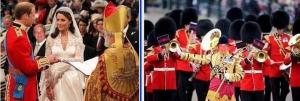
That pesky family ghost, Old Ray, is so wispy and unpredictable.
| Ray Riding in the Royal Carriage and in Sailor Uniform |
Angie, the Family Guardian Angel
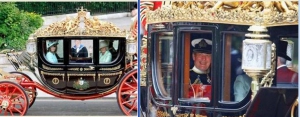
He is riding with the the Queen! How outrageous.
Notice how he kept changing clothes during the day. No wonder I could not keep up with him.

